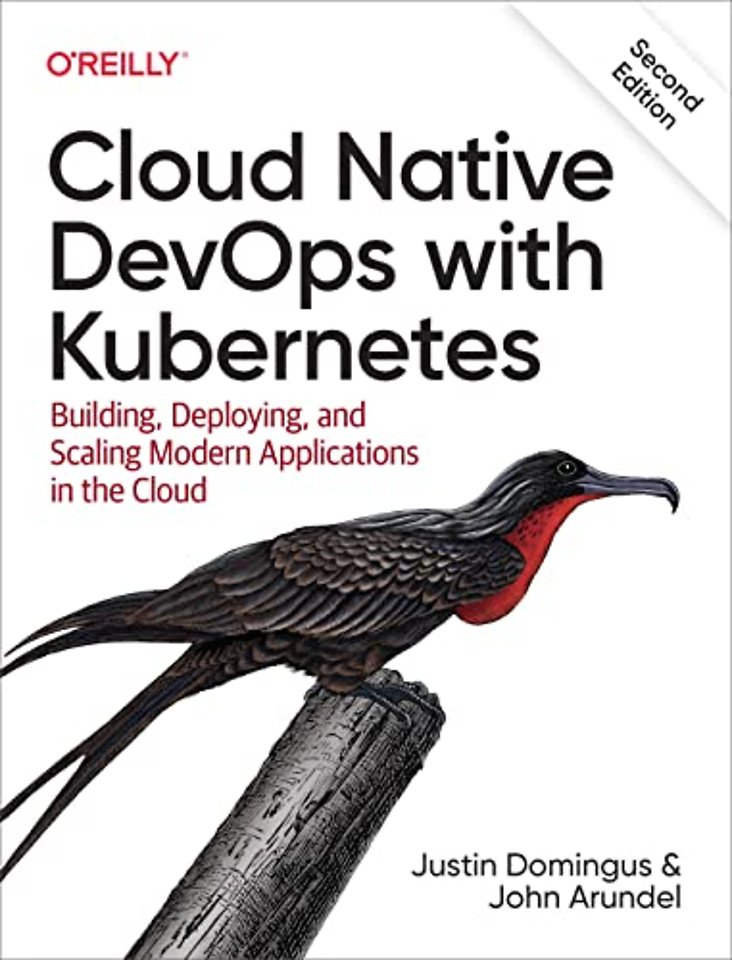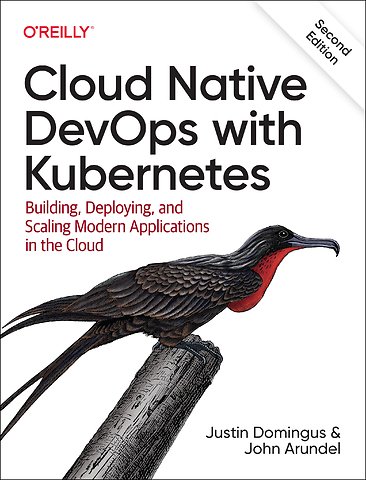Cloud Native DevOps with Kubernetes
Building, Deploying, and Scaling Modern Applications in the Cloud
Paperback Engels 2022 2e druk 9781098116828Samenvatting
Kubernetes has become the operating system of today's cloud native world, providing a reliable and scalable platform for running containerized workloads. In this friendly, pragmatic book, cloud experts Justin Domingus and John Arundel show you what Kubernetes can do-and what you can do with it.
This updated second edition guides you through the growing Kubernetes ecosystem and provides practical solutions to everyday problems with software tools currently in use. You'll walk through an example containerized application running in Kubernetes step-by-step, from the development environment through the continuous deployment pipeline, exploring patterns you can use for your own applications. Make your development teams lean, fast, and effective by adopting Kubernetes and DevOps principles.
- Understand containers and Kubernetes-no experience necessary
- Run your own applications on managed cloud Kubernetes services or on-prem environments
- Design your own cloud native services and infrastructure
- Use Kubernetes to manage resource usage and the container lifecycle
- Optimize clusters for cost, performance, resilience, capacity, and scalability
- Learn the best tools for developing, testing, and deploying your applications
- Apply the latest industry practices for observability and monitoring
- Secure your containers and clusters in production
Specificaties
Lezersrecensies
Inhoudsopgave
Foreword to the Second Edition
Foreword to the First Edition
Preface
What Will I Learn?
Who Is This Book For?
What Questions Does This Book Answer?
Conventions Used in This Book
Using Code Examples
O’Reilly Online Learning
How to Contact Us
Acknowledgments
1. Revolution in the Cloud
The Creation of the Cloud
Buying Time
Infrastructure as a Service
The Dawn of DevOps
Improving Feedback Loops
What Does DevOps Mean?
Infrastructure as Code
Learning Together
The Coming of Containers
The State of the Art
Thinking Inside the Box
Putting Software in Containers
Plug and Play Applications
Conducting the Container Orchestra
Kubernetes
From Borg to Kubernetes
Why Kubernetes?
Will Kubernetes Disappear?
Kubernetes Is Not a Panacea
Cloud Native
The Future of Operations
Distributed DevOps
Some Things Will Remain Centralized
Developer Productivity Engineering
You Are the Future
Summary
2. First Steps with Kubernetes
Running Your First Container
Installing Docker Desktop
What Is Docker?
Running a Container Image
The Demo Application
Looking at the Source Code
Introducing Go
How the Demo App Works
Building a Container
Understanding Dockerfiles
Minimal Container Images
Running Docker Image Build
Naming Your Images
Port Forwarding
Container Registries
Authenticating to the Registry
Naming and Pushing Your Image
Running Your Image
Hello, Kubernetes
Running the Demo App
If the Container Doesn’t Start
Minikube
Summary
3. Getting Kubernetes
Cluster Architecture
The Control Plane
Node Components
High Availability
The Costs of Self-Hosting Kubernetes
It’s More Work Than You Think
It’s Not Just About the Initial Setup
Tools Don’t Do All the Work for You
Kubernetes the Hard Way
Kubernetes Is Hard
Administration Overhead
Start with Managed Services
Managed Kubernetes Services
Google Kubernetes Engine (GKE)
Cluster Autoscaling
Autopilot
Amazon Elastic Kubernetes Service (EKS)
Azure Kubernetes Service (AKS)
IBM Cloud Kubernetes Service
DigitalOcean Kubernetes
Kubernetes Installers
kops
Kubespray
kubeadm
Rancher Kubernetes Engine (RKE)
Puppet Kubernetes Module
Buy or Build: Our Recommendations
Run Less Software
Use Managed Kubernetes if You Can
But What About Vendor Lock-in?
Bare-Metal and On-Prem
Multicloud Kubernetes Clusters
OpenShift
Anthos
Use Standard Kubernetes Self-Hosting Tools if You Must
Clusterless Container Services
AWS Fargate
Azure Container Instances (ACI)
Google Cloud Run
Summary
4. Working with Kubernetes Objects
Deployments
Supervising and Scheduling
Restarting Containers
Creating Deployments
Pods
ReplicaSets
Maintaining Desired State
The Kubernetes Scheduler
Resource Manifests in YAML Format
Resources Are Data
Deployment Manifests
Using kubectl apply
Service Resources
Querying the Cluster with kubectl
Taking Resources to the Next Level
Helm: A Kubernetes Package Manager
Installing Helm
Installing a Helm Chart
Charts, Repositories, and Releases
Listing Helm Releases
Summary
5. Managing Resources
Understanding Resources
Resource Units
Resource Requests
Resource Limits
Quality of Service
Managing the Container Life Cycle
Liveness Probes
Probe Delay and Frequency
Other Types of Probes
Readiness Probes
Startup Probes
gRPC Probes
File-Based Readiness Probes
minReadySeconds
Pod Disruption Budgets
Using Namespaces
Working with Namespaces
What Namespaces Should I Use?
Service Addresses
Resource Quotas
Default Resource Requests and Limits
Optimizing Cluster Costs
Kubecost
Optimizing Deployments
Optimizing Pods
Vertical Pod Autoscaler
Optimizing Nodes
Optimizing Storage
Cleaning Up Unused Resources
Checking Spare Capacity
Using Reserved Instances
Using Preemptible (Spot) Instances
Keeping Your Workloads Balanced
Summary
6. Operating Clusters
Cluster Sizing and Scaling
Capacity Planning
Nodes and Instances
Scaling the Cluster
Conformance Checking
CNCF Certification
Conformance Testing with Sonobuoy
Kubernetes Audit Logging
Chaos Testing
Only Production Is Production
chaoskube
kube-monkey
PowerfulSeal
Summary
7. Kubernetes Power Tools
Mastering kubectl
Shell Aliases
Using Short Flags
Abbreviating Resource Types
Auto-Completing kubectl Commands
Getting Help
Getting Help on Kubernetes Resources
Showing More Detailed Output
Working with JSON Data and jq
Watching Objects
Describing Objects
Working with Resources
Imperative kubectl Commands
When Not to Use Imperative Commands
Generating Resource Manifests
Exporting Resources
Diffing Resources
Working with Containers
Viewing a Container’s Logs
Attaching to a Container
Watching Kubernetes Resources with kubespy
Forwarding a Container Port
Executing Commands on Containers
Running Containers for Troubleshooting
Using BusyBox Commands
Adding BusyBox to Your Containers
Installing Programs on a Container
Contexts and Namespaces
kubeconfig files
kubectx and kubens
kube-ps1
Kubernetes Shells and Tools
kube-shell
Click
kubed-sh
Stern
Kubernetes IDEs
Lens
VS Code Kubernetes Extension
Building Your Own Kubernetes Tools
Summary
8. Running Containers
Containers and Pods
What Is a Container?
Container Runtimes in Kubernetes
What Belongs in a Container?
What Belongs in a Pod?
Container Manifests
Image Identifiers
The latest Tag
Container Digests
Base Image Tags
Ports
Resource Requests and Limits
Image Pull Policy
Environment Variables
Container Security
Running Containers as a Non-Root User
Blocking Root Containers
Setting a Read-Only Filesystem
Disabling Privilege Escalation
Capabilities
Pod Security Contexts
Pod Service Accounts
Volumes
emptyDir Volumes
Persistent Volumes
Restart Policies
Image Pull Secrets
Init Containers
Summary
9. Managing Pods
Labels
What Are Labels?
Selectors
More Advanced Selectors
Other Uses for Labels
Labels and Annotations
Node Affinities
Hard Affinities
Soft Affinities
Pod Affinities and Anti-Affinities
Keeping Pods Together
Keeping Pods Apart
Soft Anti-Affinities
When to Use Pod Affinities
Taints and Tolerations
Pod Controllers
DaemonSets
StatefulSets
Jobs
CronJobs
Horizontal Pod Autoscalers
Operators and Custom Resource Definitions (CRDs)
Ingress
Ingress Controllers
Ingress Rules
Terminating TLS with Ingress
Service Mesh
Istio
Linkerd
Consul Connect
NGINX Service Mesh
Summary
10. Configuration and Secrets
ConfigMaps
Creating ConfigMaps
Setting Environment Variables from ConfigMaps
Setting the Whole Environment from a ConfigMap
Using Environment Variables in Command Arguments
Creating Config Files from ConfigMaps
Updating Pods on a Config Change
Kubernetes Secrets
Using Secrets as Environment Variables
Writing Secrets to Files
Reading Secrets
Access to Secrets
Encryption at Rest
Keeping Secrets and ConfigMaps
Secrets Management Strategies
Encrypt Secrets in Version Control
Use a Dedicated Secrets Management Tool
Encrypting Secrets with Sops
Encrypting a File with Sops
Using a KMS Backend
Sealed Secrets
Summary
11. Security, Backups, and Cluster Health
Access Control and Permissions
Managing Access by Cluster
Introducing Role-Based Access Control (RBAC)
Understanding Roles
Binding Roles to Users
What Roles Do I Need?
Guard Access to cluster-admin
Applications and Deployment
RBAC Troubleshooting
Cluster Security Scanning
Gatekeeper/OPA
kube-bench
Kubescape
Container Security Scanning
Clair
Aqua
Anchore Engine
Synk
Backups
Do I Need to Back Up Kubernetes?
Backing Up etcd
Backing Up Resource State
Backing Up Cluster State
Large and Small Disasters
Velero
Monitoring Cluster Status
kubectl
CPU and Memory Utilization
Cloud Provider Console
Kubernetes Dashboard
Weave Scope
kube-ops-view
node-problem-detector
Further Reading
Summary
12. Deploying Kubernetes Applications
Building Manifests with Helm
What’s Inside a Helm Chart?
Helm Templates
Interpolating Variables
Quoting Values in Templates
Specifying Dependencies
Deploying Helm Charts
Setting Variables
Specifying Values in a Helm Release
Updating an App with Helm
Rolling Back to Previous Versions
Creating a Helm Chart Repo
Managing Helm Chart Secrets with Sops
Managing Multiple Charts with Helmfile
What’s in a Helmfile?
Chart Metadata
Applying the Helmfile
Advanced Manifest Management Tools
kustomize
Tanka
Kapitan
kompose
Ansible
kubeval
Summary
13. Development Workflow
Development Tools
Skaffold
Telepresence
Waypoint
Knative
OpenFaaS
Crossplane
Deployment Strategies
Rolling Updates
Recreate
maxSurge and maxUnavailable
Blue/Green Deployments
Rainbow Deployments
Canary Deployments
Handling Migrations with Helm
Helm Hooks
Handling Failed Hooks
Other Hooks
Chaining Hooks
Summary
14. Continuous Deployment in Kubernetes
What Is Continuous Deployment?
Which CD Tool Should I Use?
Hosted CI/CD Tools
Azure Pipelines
Google Cloud Build
Codefresh
GitHub Actions
GitLab CI
Self-Hosted CI/CD Tools
Jenkins
Drone
Tekton
Concourse
Spinnaker
Argo
Keel
A CI/CD Pipeline with Cloud Build
Setting Up Google Cloud and GKE
Forking the Demo Repository
Create Artifact Registry Container Repository
Configuring Cloud Build
Building the Test Container
Running the Tests
Building the Application Container
Substitution Variables
Git SHA Tags
Validating the Kubernetes Manifests
Publishing the Image
Creating the First Build Trigger
Testing the Trigger
Deploying from a CI/CD Pipeline
Creating a Deploy Trigger
Adapting the Example Pipeline
GitOps
Flux
Summary
15. Observability and Monitoring
What Is Observability?
What Is Monitoring?
Closed-Box Monitoring
What Does “Up” Mean?
Logging
Introducing Metrics
Tracing
Observability
The Observability Pipeline
Monitoring in Kubernetes
External Closed-Box Checks
Internal Health Checks
Summary
16. Metrics in Kubernetes
What Are Metrics, Really?
Time-Series Data
Counters and Gauges
What Can Metrics Tell Us?
Choosing Good Metrics
Services: The RED Pattern
Resources: The USE Pattern
Business Metrics
Kubernetes Metrics
Analyzing Metrics
What’s Wrong with a Simple Average?
Means, Medians, and Outliers
Discovering Percentiles
Applying Percentiles to Metrics Data
We Usually Want to Know the Worst
Beyond Percentiles
Graphing Metrics with Dashboards
Use a Standard Layout for All Services
Build an Information Radiator with Primary Dashboards
Dashboard Things That Break
Alerting on Metrics
What’s Wrong with Alerts?
On-Call Should Not Be Hell
Urgent, Important, and Actionable Alerts
Track Your Alerts, Out-of-Hours Pages, and Wake-Ups
Metrics Tools and Services
Prometheus
Google Operations Suite
AWS CloudWatch
Azure Monitor
Datadog
New Relic
Summary
Afterword
Where to Go Next
Second Edition Notes
Welcome Aboard
Index
About the Authors
Anderen die dit boek kochten, kochten ook
Rubrieken
- advisering
- algemeen management
- coaching en trainen
- communicatie en media
- economie
- financieel management
- inkoop en logistiek
- internet en social media
- it-management / ict
- juridisch
- leiderschap
- marketing
- mens en maatschappij
- non-profit
- ondernemen
- organisatiekunde
- personal finance
- personeelsmanagement
- persoonlijke effectiviteit
- projectmanagement
- psychologie
- reclame en verkoop
- strategisch management
- verandermanagement
- werk en loopbaan







